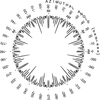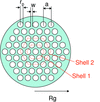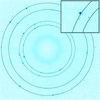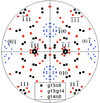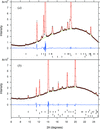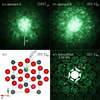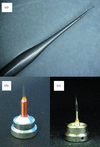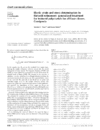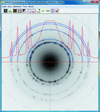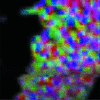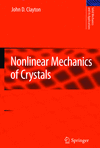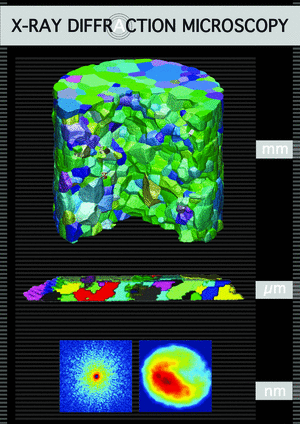issue contents
August 2012 issue

Cover illustration: Example of a three-dimensional reciprocal-space map recorded from a sample of GaAs nanowires grown on GaAs. Courtesy of Schlepütz et al. [J. Appl. Cryst. (2011), 44, 73-83].
research papers
In this work, a study of the mirror symmetries appearing in multiple diffraction patterns of face-centred cubic crystals is carried out. It is shown that isomorphic and anamorphic mirrors coexist in these patterns.
A genetic algorithm was used to successfully optimize the work hardening coefficients of a polycrystalline plasticity model.
The anomalous small-angle X-ray scattering technique is applied to determine quantitative information about the structure and composition of magnetic nanoparticles and their environment in silicate glasses.
X-ray photons with energy higher than usual improve both the number and the quality of diffraction data from a given macromolecular crystal.
Small-angle scattering profiles of mesoporous materials are measured in absolute units and quantitatively compared with calculated profiles. This treatment allows the determination of the mesoporous specific surface of these materials without resorting to gas adsorption measurements.
A simple and robust instrument, which overcomes the crystal settling that impairs serial femtosecond crystallography experiments, is described.
A large and unidirectional single crystal of technologically important L-arginine phosphate monohydrate has been grown for the first time by the recently invented Sankaranarayanan–Ramasamy method. The crystalline perfection and the mechanical and dielectric properties have been assessed and correlated.
Techniques used to cryocool large protein crystals (1–6 mm3) successfully are described. High-resolution cryo-neutron crystallography data were collected at 15 K for three test systems.
A fast and robust methodology is developed for the analysis of two-dimensional diffraction data containing peak overlap, acquired from polycrystalline materials consisting of thousands of grains using three-dimensional X-ray diffraction. This first part outlines the procedure for the accurate identification and characterization of overlapping diffraction peaks and the determination of the parameters of the experimental setup without the need for calibration samples.
A fast and robust methodology is developed for the analysis of two-dimensional diffraction data acquired from samples containing thousands of grains using three-dimensional X-ray diffraction. This second part deals with the procedure for the determination of grain characteristics. The volume, crystallographic orientation, centre-of-mass position and strain state of individual grains can be determined simultaneously.
In the present study, the precipitation of a face-centred cubic carbide in a face-centred cubic matrix was observed for the first time in the absence of the cube–cube orientation relationship. This crystallographic orientation anomaly was characterized by a new method using transmission electron microscopy.
Download citation


Download citation


The high-pressure structures of NiSi and their room-temperature equations of state have been investigated using synchrotron X-ray diffraction in a diamond anvil cell, coupled with laser annealing. An ∊-FeSi-structured phase was found to form above ∼13 GPa and a CsCl-structured phase above ∼61 GPa.
Atomic selectivity in X-ray diffraction has been achieved by varying the X-ray energy, and thus the resonant scattering contributions, using the recently proposed modulation enhanced diffraction approach. A general experimental recipe is given, and possible schemes for data analysis are introduced, tested and discussed.
Time-dependent microbeam X-ray diffraction experiments have been performed on the isothermal austenite-to-martensite transformation in maraging steel. The transformation behaviour of a set of individual austenite grains is monitored in detail and correlated to the microstructural features.
A modification to the vapor diffusion protein crystallization method, named the gradual desiccation method, is reported. It was found that this method can significantly enhance crystallization of proteins.
Selected area electron diffraction (SAED) patterns along the main pseudo-cubic axes, which show a splitting of reflections, are calculated for tetragonal and rhombohedral distortions present around the morphotropic phase boundary of PbZr1−xTixO3 (PZT). If a defined splitting is observed it might be used to estimate the lattice distortion, although for a detailed analysis, especially to distinguish the monoclinic phase, convergent-beam electron diffraction is required.
Open  access
access
 access
accessA complex three-dimensional quantitative image of an extended zinc oxide crystal has been obtained using Bragg coherent diffraction imaging integrated with ptychography.
It is demonstrated that a cryocrystallographic mounting method using a fine-needle capillary is suitable for protein microcrystals.
A new method for recovering atom positions missing in a structure model obtained at the end of the ab initio solution process has been developed.
A Bragg peak shift suggests a pore lattice expansion in ordered nanoporous silica at the onset of capillary condensation of fluids. In depth analysis by a numerical and an analytical approach leads to the conclusion that this shift is due not to a mechanical deformation of the pore lattice but to a subtle interplay between the form factor and the structure factor from crystallites of finite size.
Structural relaxations in a molecular glass former were probed by X-ray photon correlation spectroscopy. The time-dependent intermediate scattering function was calculated using a novel event correlation algorithm that takes both single- and multiple-photon events into account.
The different Zeeman energy effects in neutron reflectivity experiments and their influence on beam splitting are reviewed. The representation of Zeeman splitting data in several coordinate systems is discussed, and the use of such data to directly extract information on magnetic thin-film systems is examined.
Micro X-ray diffraction and mechanical modeling on low-energy (60 keV) light-ion (He)-implanted polycrystals have shown that the strain tensor has only three nonzero components, which depend on grain orientation.
teaching and education
Free 

The common misinterpretation of a special orbit in centrosymmetric space groups as a general orbit in a polar subgroup is pointed out through some of the examples in IUCr Teaching Pamphlet No. 14, and an alternative interpretation is given.
short communications
Errors in the article by Popa & Balzar [J. Appl. Cryst. (2001), 34, 187–195], caused by an equation from literature used without checking, are corrected. It is expected that other published papers will have been affected as the source error is in a reference book.
computer programs
Bonsu is an open-source software package primarily for the reconstruction of phase information from coherent X-ray diffraction measurements.
The interactive powder diffraction program DAJUST for whole-pattern matching, space-group determination and extraction of integrated intensities is described. The resulting intensity data files are compatible with the XLENS (Patterson function direct methods) and TALP (direct-space multisolution methods) programs of the authors' laboratory (ICMAB, CSIC).
The programs WinGX and ORTEP for Windows have been distributed over the internet for about 15 years, and this article describes some of the more modern features of the programs.
A computer program is reported for the structure solution of extended inorganic frameworks in real space. The space group and cell parameters are the basic inputs required by this program. Prior chemical and crystallographic knowledge can significantly enhance its computation efficiency.
A computer program, QPCED2.0, has been developed for the handling of selected-area electron diffraction patterns for polycrystalline materials. The design and implementation of QPCED2.0 are elucidated and application examples are given.
laboratory notes
A first-generation-synchrotron-class X-ray laboratory microsource, coupled to a three-pinhole camera, is presented. It allows small- and wide-angle X-ray scattering images to be acquired simultaneously, and scanning small- and wide-angle X-ray scattering microscopy to be carried out.
books received
Free 



 journal menu
journal menu








